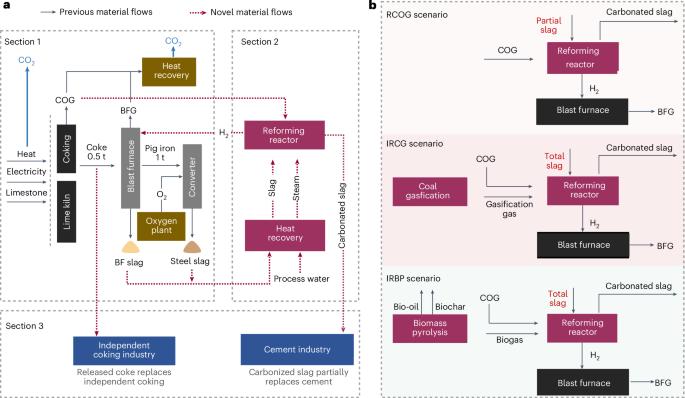Synergistic gas–slag scheme to mitigate CO2 emissions from the steel industry
IF 27.1
1区 环境科学与生态学
Q1 ENVIRONMENTAL SCIENCES
引用次数: 0
Abstract
Improving the sustainability of the steel industry requires decarbonization strategies that are both technically and economically viable. The recovery of both material and heat on site is a promising approach but largely unexplored. Here we propose a scheme integrating heat recovery, carbon mineralization and the use of slag in cement production, along with the blast-furnace injection of hydrogen from off-gas. The proposed scheme, based on the synergistic use of coke oven gas and slag, can reduce CO2 emissions by 48% compared to the conventional approach. When coupled with an external gas supply from coal gasification or biomass pyrolysis, CO2 emissions can drop by 63% and 92%, respectively. The cost of avoiding CO2 emissions could be less than half the cost of conventional industrial capture and could be offset by the projected carbon price by 2030. For the steel industry in China, we find that the scheme is applicable to over 46% of existing steel mills, resulting in 16 provinces meeting the 2 °C target and 19 provinces surpassing the 50% national mitigation target. Overall, we have shown how a minor reconfiguration of the steel production process could substantially improve the sustainability of the steel industry. Decarbonizing the steel industry is essential for achieving sustainable development. Here the authors propose a decarbonization strategy for the steel industry that could substantially reduce carbon emissions and is easily adaptable to existing facilities.

协同气渣方案,以减少二氧化碳排放的钢铁工业
提高钢铁工业的可持续性需要在技术上和经济上都可行的脱碳战略。就地回收材料和热量是一种很有前途的方法,但在很大程度上尚未被探索。在这里,我们提出了一个集热回收、碳矿化和矿渣在水泥生产中的利用以及高炉喷射废气氢为一体的方案。该方案基于焦炉煤气和炉渣的协同利用,与传统方法相比,可减少48%的二氧化碳排放。当加上来自煤炭气化或生物质热解的外部气体供应时,二氧化碳排放量可以分别下降63%和92%。避免二氧化碳排放的成本可能不到传统工业捕集成本的一半,并且可以被预计到2030年的碳价格抵消。对于中国的钢铁行业,我们发现该方案适用于超过46%的现有钢厂,从而使16个省份达到了2°C的目标,19个省份超过了50%的国家减排目标。总的来说,我们已经展示了钢铁生产过程的一个小的重新配置如何能够大大提高钢铁工业的可持续性。使钢铁工业脱碳对实现可持续发展至关重要。在这里,作者为钢铁行业提出了一种脱碳策略,可以大幅减少碳排放,并且很容易适应现有设施。
本文章由计算机程序翻译,如有差异,请以英文原文为准。
求助全文
约1分钟内获得全文
求助全文
来源期刊

Nature Sustainability
Energy-Renewable Energy, Sustainability and the Environment
CiteScore
41.90
自引率
1.10%
发文量
159
期刊介绍:
Nature Sustainability aims to facilitate cross-disciplinary dialogues and bring together research fields that contribute to understanding how we organize our lives in a finite world and the impacts of our actions.
Nature Sustainability will not only publish fundamental research but also significant investigations into policies and solutions for ensuring human well-being now and in the future.Its ultimate goal is to address the greatest challenges of our time.
 求助内容:
求助内容: 应助结果提醒方式:
应助结果提醒方式:


